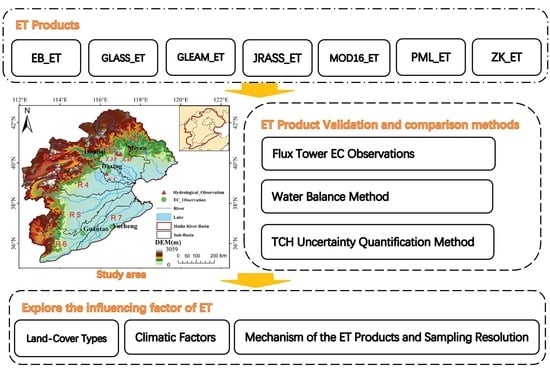Validation and Comparison of Seven Land Surface Evapotranspiration Products in the Haihe River Basin, China
Abstract
:1. Introduction
2. Materials and Methods
2.1. Study Area
2.2. Datasets
2.2.1. The Evaluated ET Products
2.2.2. Other Datasets
2.3. Methods
2.3.1. ET Product Validation Using Flux Tower EC Observations
2.3.2. ET Product Validation Using Water Balance Method
2.3.3. ET Product Comparison Using TCH Uncertainty Quantification Method
2.3.4. Cosine Similarity
3. Results and Analysis
3.1. Results of ET Product Validation Using Flux Tower EC Observations
3.2. Results of ET Product Validation Using Water Balance Method
3.3. Results of ET Product Comparison Using TCH Uncertainty Quantification
4. Discussion
4.1. Spatial Distribution of ET under Different Land-Cover Types
4.2. Analysis of the Influence of Climatic Factors on ET
4.3. Sampling Resolution and the Mechanism of the ET Products
5. Conclusions
- For validation based on flux tower EC observations, the results indicate that, except for MOD16_ET and EB_ET, the R values were all greater than 0.6. The BIAS values of GLASS_ET were the lowest (2.93 w/m2). GLEAM_ET had the highest R (0.77) value and the lowest RMSD’ (27.3 w/m2). Overall, the GLEAM data fitted the EC measured data well, and the RMSD values were relatively low;
- Based on the validation using the water balance method, the EB_ET, GLEAM_ET, JRA_ET, PML_ET, and ZK_ET overestimated the values in the Haihe River Basin. The multi-year averaged monthly evapotranspiration of the WB_ET and the ET products showed that the EB_ET and GLEAM_ET were in good agreement with the WB_ET. Overall, the JRA_ET (R = 0.92, BIAS = 13.72 mm/month, and RMSD′ = 10.96 mm/month) and GLEAM_ET (R = 0.91, BIAS = 9.14 mm/month, and RMSD′ = 11.00 mm/month) data have higher accuracies;
- For the uncertainty analysis based on the TCH method, the average relative uncertainties of the GLEAM data were significantly lower than those of the other ET products. The relative uncertainties of the JRA_ET and ZK_ET were relatively high in the mountainous areas. The PML_ET had higher relative uncertainties in the non-mountainous areas. The performances of the EB_ET, GLEAM_ET, and MOD16_ET in the mountainous and non-mountainous areas were relatively equal.
Author Contributions
Funding
Data Availability Statement
Acknowledgments
Conflicts of Interest
References
- Xu, T.; Guo, Z.; Xia, Y.; Ferreira, V.G.; Liu, S.; Wang, K.; Yao, Y.; Zhang, X.; Zhao, C. Evaluation of Twelve Evapotranspiration Products from Machine Learning, Remote Sensing and Land Surface Models over Conterminous United States. J. Hydrol. 2019, 578, 124105. [Google Scholar] [CrossRef]
- Jung, M.; Reichstein, M.; Ciais, P.; Seneviratne, S.I.; Sheffield, J.; Goulden, M.L.; Bonan, G.; Cescatti, A.; Chen, J.; De Jeu, R.; et al. Recent decline in the global land evapotranspiration trend due to limited moisture supply. Nature 2010, 467, 951–954. [Google Scholar] [CrossRef] [PubMed]
- Vinukollu, R.K.; Wood, E.F.; Ferguson, C.R.; Fisher, J.B. Global estimates of evapotranspiration for climate studies using multi-sensor remote sensing data: Evaluation of three process-based approaches. Remote Sens. Environ. 2011, 115, 801–823. [Google Scholar] [CrossRef]
- Miralles, D.G.; Holmes, T.R.H.; De Jeu, R.A.M.; Gash, J.H.; Meesters, A.G.C.A.; Dolman, A.J. Global land-surface evaporation estimated from satellite-based observations. Hydrol. Earth Syst. Sci. 2011, 15, 453–469. [Google Scholar] [CrossRef]
- Mu, Q.; Zhao, M.; Running, S.W. Improvements to a MODIS global terrestrial evapotranspiration algorithm. Remote Sens. Environ. 2011, 115, 1781–1800. [Google Scholar] [CrossRef]
- Zhang, Y.; Kong, D.; Gan, R.; Chiew, F.H.S.; McVicar, T.R.; Zhang, Q.; Yang, Y. Coupled estimation of 500 m and 8-day resolution global evapotranspiration and gross primary production in 2002–2017. Remote Sens. Environ. 2019, 222, 165–182. [Google Scholar] [CrossRef]
- Chen, X.; Su, Z.; Ma, Y.; Trigo, I.; Gentine, P. Remote Sensing of Global Daily Evapotranspiration based on a Surface Energy Balance Method and Reanalysis Data. J. Geophys. Res. Atmos. 2021, 126, e2020JD032873. [Google Scholar] [CrossRef]
- Su, Z. The surface energy balance system SEBS for estimation of turbulent heat fluxes. Hydrol. Earth Syst. Sci. 2002, 6, 85–100. [Google Scholar] [CrossRef]
- Kobayashi, S.; Ota, Y.; Harada, Y.; Ebita, A.; Moriya, M.; Onoda, H.; Onogi, K.; Kamahori, H.; Kobayashi, C.; Endo, H.; et al. The JRA-55 Reanalysis: General Specifications and Basic Characteristics. J. Meteorol. Soc. Jpn. Ser. II 2015, 93, 5–48. [Google Scholar] [CrossRef]
- Xu, J.Z.; Peng, S.Z.; Zhang, R.M.; Li, D.X. Neural network model for reference crop evapotranspiration prediction based on weather forecast. ASCE J. Hydraul. Div. 2006, 37, 376–379. [Google Scholar]
- Xu, S.; Wu, C.; Wang, L.; Gonsamo, A.; Shen, Y.; Niu, Z. A new satellite-based monthly precipitation downscaling algorithm with non-stationary relationship between precipitation and land surface characteristics. Remote Sens. Environ. 2015, 162, 119–140. [Google Scholar] [CrossRef]
- Baik, J.; Liaqat, U.W.; Choi, M. Assessment of satellite- and reanalysis-based evapotranspiration products with two blending approaches over the complex landscapes and climates of Australia. Agric. For. Meteorol. 2018, 263, 388–398. [Google Scholar] [CrossRef]
- Miralles, D.G.; Jiménez, C.; Jung, M.; Michel, D.; Ershadi, A.; McCabe, M.F.; Hirschi, M.; Martens, B.; Dolman, A.J.; Fisher, J.B.; et al. The WACMOS-ET project-part 2: Evaluation of global terrestrial evaporation data sets. Hydrol. Earth Syst. Sci. 2016, 20, 823–842. [Google Scholar] [CrossRef]
- Zhang, Y.; Jia, Z.Z.; Liu, S.M.; Xu, Z.W.; Xu, T.R.; Yao, Y.J.; Ma, Y.F.; Song, L.S.; Li, X.; Hu, X.; et al. Advances in validation of remotely sensed land surface evapotranspiration. J. Remote Sens. 2020, 24, 975–999. [Google Scholar]
- Velpuri, N.M.; Senay, G.B.; Singh, R.K.; Bohms, S.; Verdin, J.P. A comprehensive evaluation of two MODIS evapotranspiration products over the conterminous United States: Using point and gridded FLUXNET and water balance ET. Remote Sens. Environ. 2013, 139, 35–49. [Google Scholar] [CrossRef]
- Bai, J.; Jia, L.; Liu, S.M.; Xu, Z.; Hu, G.; Zhu, M.; Song, L. Characterizing the Footprint of Eddy Covariance System and Large Aperture Scintillometer Measurements to Validate Satellite-Based Surface Fluxes. IEEE Geosci. Remote Sens. Lett. 2015, 12, 943–947. [Google Scholar] [CrossRef]
- Soltani, M.; Koch, J.; Stisen, S. Using a Groundwater Adjusted Water Balance Approach and Copulas to Evaluate Spatial Patterns and Dependence Structures in Remote Sensing Derived Evapotranspiration Products. Remote Sens. 2021, 13, 853. [Google Scholar] [CrossRef]
- Liu, Y.; Yang, Z.; Lin, P.; Zheng, Z.; Xie, S. Comparison and evaluation of multiple land surface products for the water budget in the Yellow River Basin. J. Hydrol. 2019, 584, 124534. [Google Scholar] [CrossRef]
- Sriwongsitanon, N.; Suwawong, T.; Thianpopirug, S.; Williams, J.; Jia, L.; Bastiaanssen, W. Validation of seven global remotely sensed ET products across Thailand using water balance measurements and land use classifications. J. Hydrol. Reg. Stud. 2020, 30, 100709. [Google Scholar] [CrossRef]
- Weerasinghe, I.; Bastiaanssen, W.; Mul, M.; Jia, L.; Van Griensven, A. Can we trust remote sensing evapotranspiration products over Africa. Hydrol. Earth Syst. Sci. 2020, 24, 1565–1586. [Google Scholar] [CrossRef]
- Ruhoff, A.; de Andrade, B.C.; Laipelt, L.; Fleischmann, A.S.; Siqueira, V.A.; Moreira, A.A.; Barbedo, R.; Cyganski, G.L.; Fernandez, G.M.R.; Brêda, J.P.L.F.; et al. Global Evapotranspiration Datasets Assessment Using Water Balance in South America. Remote Sens. 2022, 14, 2526. [Google Scholar] [CrossRef]
- Xu, T.; Guo, Z.; Liu, S.; He, X.; Meng, Y.; Xu, Z.; Xia, Y.; Xiao, J.; Zhang, Y.; Ma, Y.; et al. Evaluating different machine learning methods for upscaling evapotranspiration from flux towers to the regional scale. J. Geophys. Res. Atmos. 2018, 123, 8674–8690. [Google Scholar] [CrossRef]
- Timmermans, W.J.; Kustas, W.P.; Anderson, M.C.; French, A.N. An intercomparison of the Surface Energy Balance Algorithm for Land (SEBAL) and the Two-Source Energy Balance (TSEB) modeling schemes. Remote Sens. Environ. 2007, 108, 369–384. [Google Scholar] [CrossRef]
- Khan, M.S.; Liaqat, U.W.; Baik, J.; Choi, M. Stand-alone uncertainty characterization of GLEAM, GLDAS and MOD16 evapotranspiration products using an extended triple collocation approach. Agric. For. Meteorol. 2018, 252, 256–268. [Google Scholar] [CrossRef]
- Long, D.; Longuevergne, L.; Scanlon, B.R. Uncertainty in evapotranspiration from land surface modeling, remote sensing, and GRACE satellites. Water Resour. Res. 2014, 50, 1131–1151. [Google Scholar] [CrossRef]
- Premoli, A.; Tavella, P. A revisited three-cornered hat method for estimating frequency standard instability. IEEE Trans. Instrum. Meas. 1993, 42, 7–13. [Google Scholar] [CrossRef]
- Tavella, P.; Premoli, A. Estimating the instabilities of N clocks by measuring differences of their readings. Metrologia 1994, 30, 479. [Google Scholar] [CrossRef]
- Koot, L.; Viron, O.D.; Dehant, V. Atmospheric angular momentum time-series: Characterization of their internal noise and creation of a combined series. J. Geod. 2006, 79, 663–674. [Google Scholar] [CrossRef]
- Yao, C.; Li, Q.; Luo, Z.; Wang, C.; Zhou, B. Uncertainties in GRACE-derived terrestrial water storage changes over mainland China based on a generalized three-cornered hat method. Chin. J. Geophys. 2019, 62, 883–897. [Google Scholar]
- Galindo, F.J.; Palacio, J. Post-processing ROA data clocks for optimal stability in the ensemble timescale. Metrologia 2003, 40, S237–S244. [Google Scholar] [CrossRef]
- Ferreira, V.G.; Montecino, H.D.C.; Yakubu, C.I.; Heck, B. Uncertainties of the gravity recovery and climate experiment time-variable gravity-field solutions based on three-cornered hat method. J. Appl. Remote Sens. 2016, 10, 015015. [Google Scholar] [CrossRef]
- Zhou, Y.J.; Liu, T.X.; Duan, L.M.; Wang, Y.X.; Li, X.; Li, M.Y. Estimation of evapotranspiration and its spatiotemporal characteristics in the upper reaches of the Xilin River Basin. Arid Zone Res. 2020, 37, 974–984. [Google Scholar]
- Liu, M.Q.; Hu, D.Y.; Yu, C.; Wang, S.S. Temporal and spatial change characteristics of growing season evapotranspiration and its cause analysis in Liaohe River delta wetland. Acta Ecol. Sin. 2020, 40, 701–710. [Google Scholar]
- Chao, L.; Zhang, K.; Wang, J.; Feng, J.; Zhang, M. A Comprehensive Evaluation of Five Evapotranspiration Datasets Based on Ground and GRACE Satellite Observations: Implications for Improvement of Evapotranspiration Retrieval Algorithm. Remote Sens. 2021, 13, 2414. [Google Scholar] [CrossRef]
- Wartenburger, R.; Seneviratne, S.I.; Hirschi, M.; Chang, J.F.; Ciais, P.; Deryng, D.; Elliott, J.; Folberth, C.; Gosling, S.N.; Gudmundsson, L.; et al. Evapotranspiration simulations in ISIMIP2a—Evaluation of spatio-temporal characteristics with a comprehensive ensemble of independent datasets. Environ. Res. Lett. 2018, 13, 075001. [Google Scholar] [CrossRef]
- Xie, X.H.; Wu, L.; Wei, J.M.; Lv, J.N.; Li, C.B. Applicability assessment of AET products in the alpine regions of Northwestern China. J. Lanzhou Univ. Med. Sci. 2021, 57, 437–446. [Google Scholar]
- Wu, J.; Lakshmi, V.; Wang, D.; Lin, P.; Pan, M.; Cai, X.; Wood, E.F.; Zeng, Z. The Reliability of Global Remote Sensing Evapotranspiration Products over Amazon. Remote Sens. 2020, 12, 2211. [Google Scholar] [CrossRef]
- Khan, M.S.; Baik, J.; Choi, M. Inter-comparison of evapotranspiration datasets over heterogeneous landscapes across Australia. Adv. Space Res. 2020, 66, 533–545. [Google Scholar] [CrossRef]
- Sörensson, A.A.; Ruscica, R. Intercomparison and uncertainty assessment of nine evapotranspiration estimates over South America. Water Resour. Res. 2018, 54, 2891–2908. [Google Scholar] [CrossRef]
- Panahi, D.M.; Tabas, S.S.; Kalantari, Z.; Ferreira, C.; Zahabiyoun, B. Spatio-temporal assessment of global gridded evapotranspiration datasets across Iran. Remote Sens. 2021, 13, 1816. [Google Scholar] [CrossRef]
- Peng, B.; Liu, X. Intercomparison and evaluation of three global high-resolution evapotranspiration products across China. J. Hydrol. 2018, 566, 743–755. [Google Scholar]
- Chen, X.; Liu, Y.; Sun, Z.; Zhang, J.; Guan, T.; Jin, J.; Liu, C.; Wang, G.; Bao, Z. Centennial Precipitation Characteristics Change in Haihe River Basin, China. Atmosphere 2022, 13, 1025. [Google Scholar] [CrossRef]
- Peng, C.J. Study on to division of Qingshan River Basin based on HEC-GeoHMS module. Water Resour. Inf. 2019, 3, 32–36. [Google Scholar]
- Chen, X.; Su, Z.; Ma, Y.; Yang, K.; Wen, J.; Zhang, Y. An Improvement of Roughness Height Parameterization of the Surface Energy Balance System (SEBS) over the Tibetan Plateau. J. Appl. Meteorol. Clim. 2013, 52, 607–622. [Google Scholar] [CrossRef]
- Martens, B.; Gonzalez Miralles, D.; Lievens, H.; Van Der Schalie, R.; De Jeu, R.A.M.; Fernández-Prieto, D.; Beck, H.E.; Dorigo, W.A.; Verhoest, N.E.C. GLEAM v3: Satellite-based land evaporation and root-zone soil moisture. Geosci. Model Dev. 2017, 10, 1903–1925. [Google Scholar] [CrossRef]
- Yao, Y.; Liang, S.; Li, X.; Hong, Y.; Fisher, J.; Zhang, N.; Chen, J.; Cheng, J.; Zhao, S.; Zhang, X.; et al. Bayesian multimodel estimation of global terrestrial latent heat flux from eddy covariance, meteorological, and satellite observations. J. Geophys. Res. Atmos. 2014, 119, 4521–4545. [Google Scholar] [CrossRef]
- Zhang, K.; Kimball, J.S.; Nemani, R.R.; Running, S.W. A continuous satellite-derived global record of land surface evapotranspiration from 1983 to 2006. Water Resour. Res. 2010, 46. [Google Scholar] [CrossRef]
- Wahr, J.; Swenson, S.; Zlotnicki, V.; Velicogna, I. Time-variable gravity from GRACE: First results. Geophys. Res. Lett. 2004, 31, L11501. [Google Scholar] [CrossRef] [Green Version]
- Hobeichi, S.; Abramowitz, G.; Evans, J.; Beck, H.E. Linear Optimal Runoff Aggregate (LORA): A global gridded synthesis runoff product. Hydrol. Earth Syst. Sci. 2019, 23, 851–870. [Google Scholar] [CrossRef]
- Ministry of Water Resources of the People’s Republic of China. China River Sediment Bulletin (2003) [R]; China Water Power Press: Beijing, China, 2004.
- Yao, Y.; Liang, S.; Li, X.; Zhang, Y.; Chen, J.; Jia, K.; Zhang, X.; Fisher, J.B.; Wang, X.; Zhang, L.; et al. Estimation of high-resolution terrestrial evapotranspiration from Landsat data using a simple Taylor skill fusion method. J. Hydrol. 2017, 553, 508–526. [Google Scholar] [CrossRef]
- Ferreira, V.G.; Gong, Z.; He, X.; Zhang, Y.; Andam-Akorful, S.A. Estimating total discharge in the yangtze river basin using satellite-based observations. Remote Sens. 2013, 5, 3415–3430. [Google Scholar] [CrossRef]
- da Silva, M.R.; de Carvalho, O.A.; Guimarães, R.F.; Trancoso Gomes, R.A.; Rosa Silva, C. Wheat planted area detection from the MODIS NDVI time series classification using the nearest neighbour method calculated by the Euclidean distance and cosine similarity measures. Geocarto Int. 2020, 35, 1400–1414. [Google Scholar] [CrossRef]
- Wang, G.; Li, S.J.; Zhang, X.G. Classification of Geomorphic Forms of Huaihe River Source Based on DEM. Bull. Soil Water Conserv. 2018, 38, 292–296. [Google Scholar]
- Sriwongsitanon, N.; Taesombat, W. Effects of land cover on runoff coefficient. J. Hydrol. 2011, 410, 226–238. [Google Scholar] [CrossRef]
- Chen, X.; Massman, W.J.; Su, Z. A column canopy-air turbulent diffusion method for different canopy structures. J. Geophys. Res. Atmos. 2019, 124, 488–506. [Google Scholar] [CrossRef]
- Yao, G.Z.; Wang, W.G.; Li, J.X. Evaluation of various remote sensing evapotranspiration products in the Han River Basin. China Rural. Water Resour. Hydropower 2018, 5, 103–108. [Google Scholar]
- Wang, S.; Tian, W.; Liu, X.M.; Liu, C.M. Comparisons of various evapotranspiration products in the Hanjiang River Basin. South-to-North Water Transf. Water Sci. Technol. 2018, 16, 1–9. [Google Scholar]
- Wang, J.Q.; Ye, J.S.; Fan, Y. Applicability evaluation of reference crop evapotranspiration calculation models in different climatic regions of China. Water Sav. Irrig. 2022, 47, 82–91. [Google Scholar]
- Yang, Z.L.; Li, Y.Z.; Bai, P.; Du, S.W.; Hao, Y.; Qian, C.; Li, C.F. Spatial-temporal Dynamics of Evapotranspiration and Its Components in Nine River Basins of China from 1980 to 2020 based on GLEAM-ET Products. J. Geo-Inf. Sci. 2022, 24, 889–901. [Google Scholar] [CrossRef]
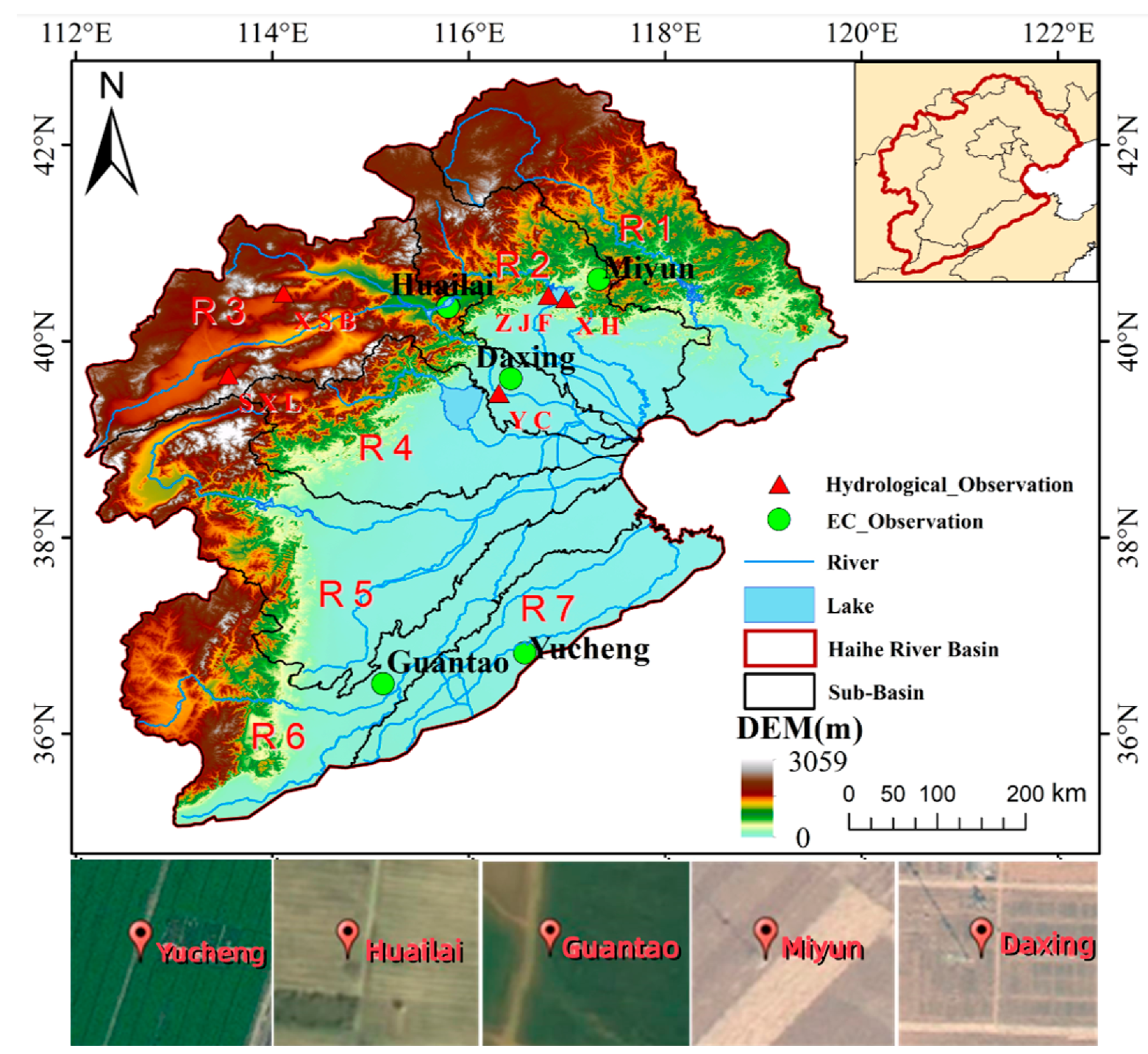
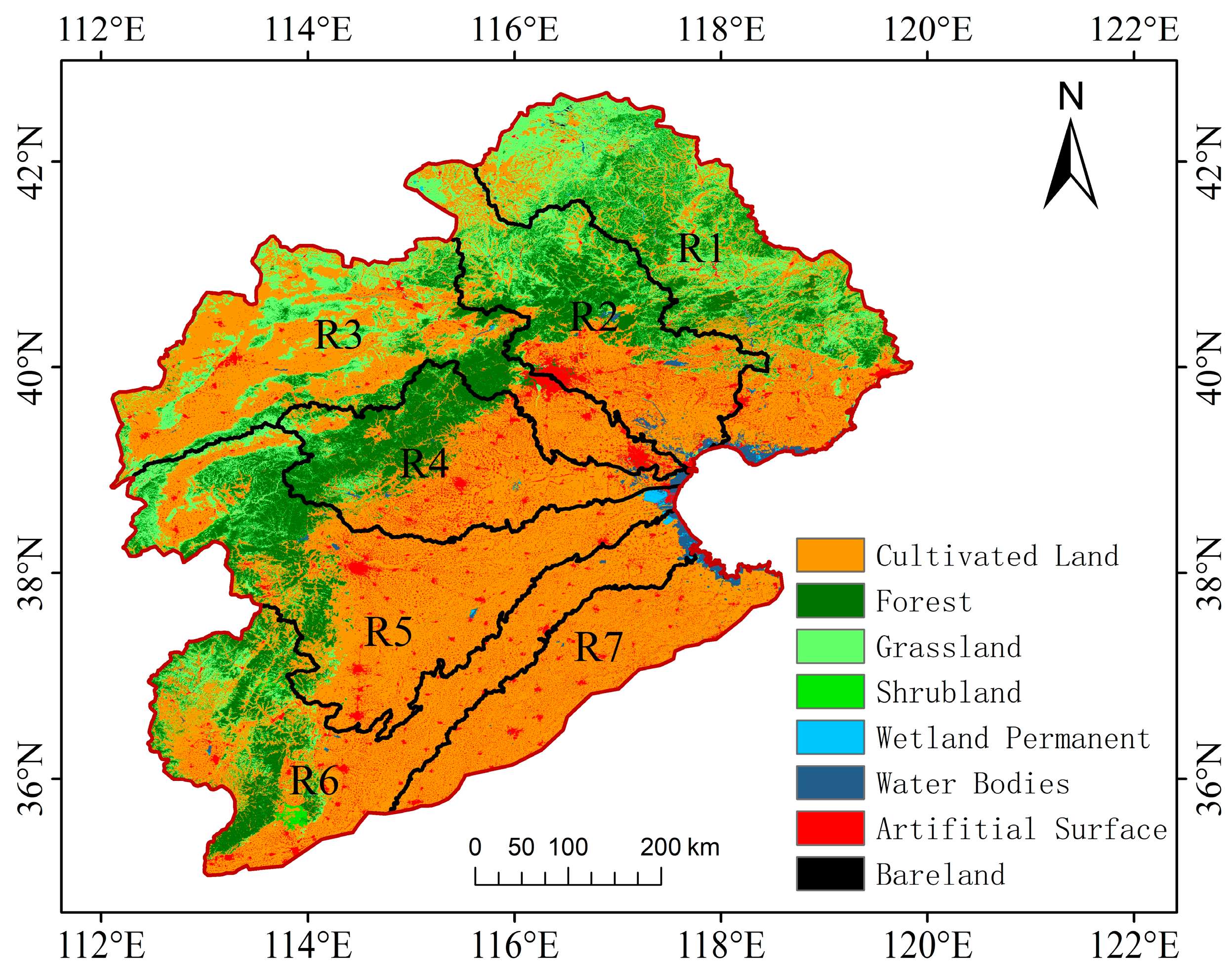
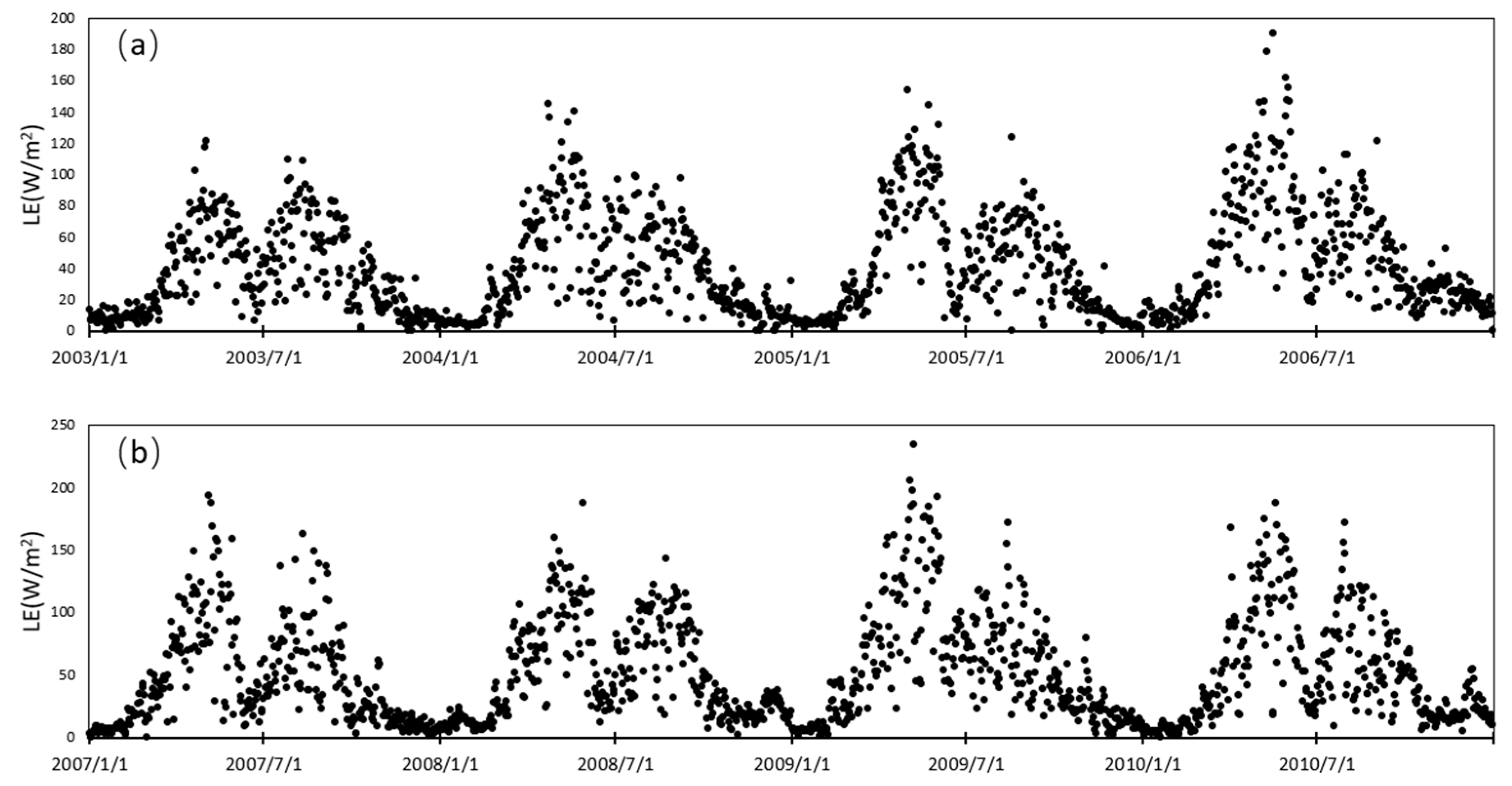
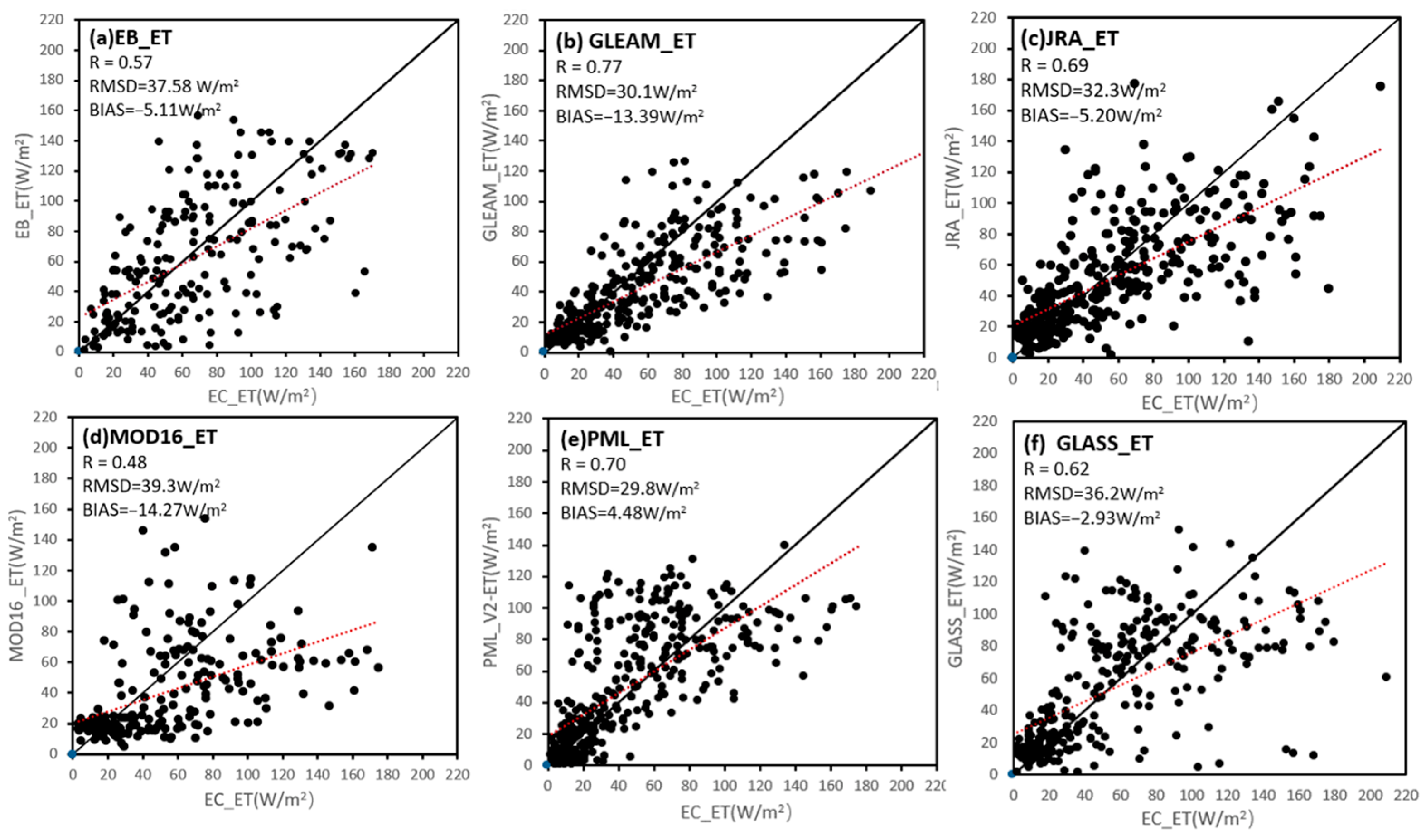
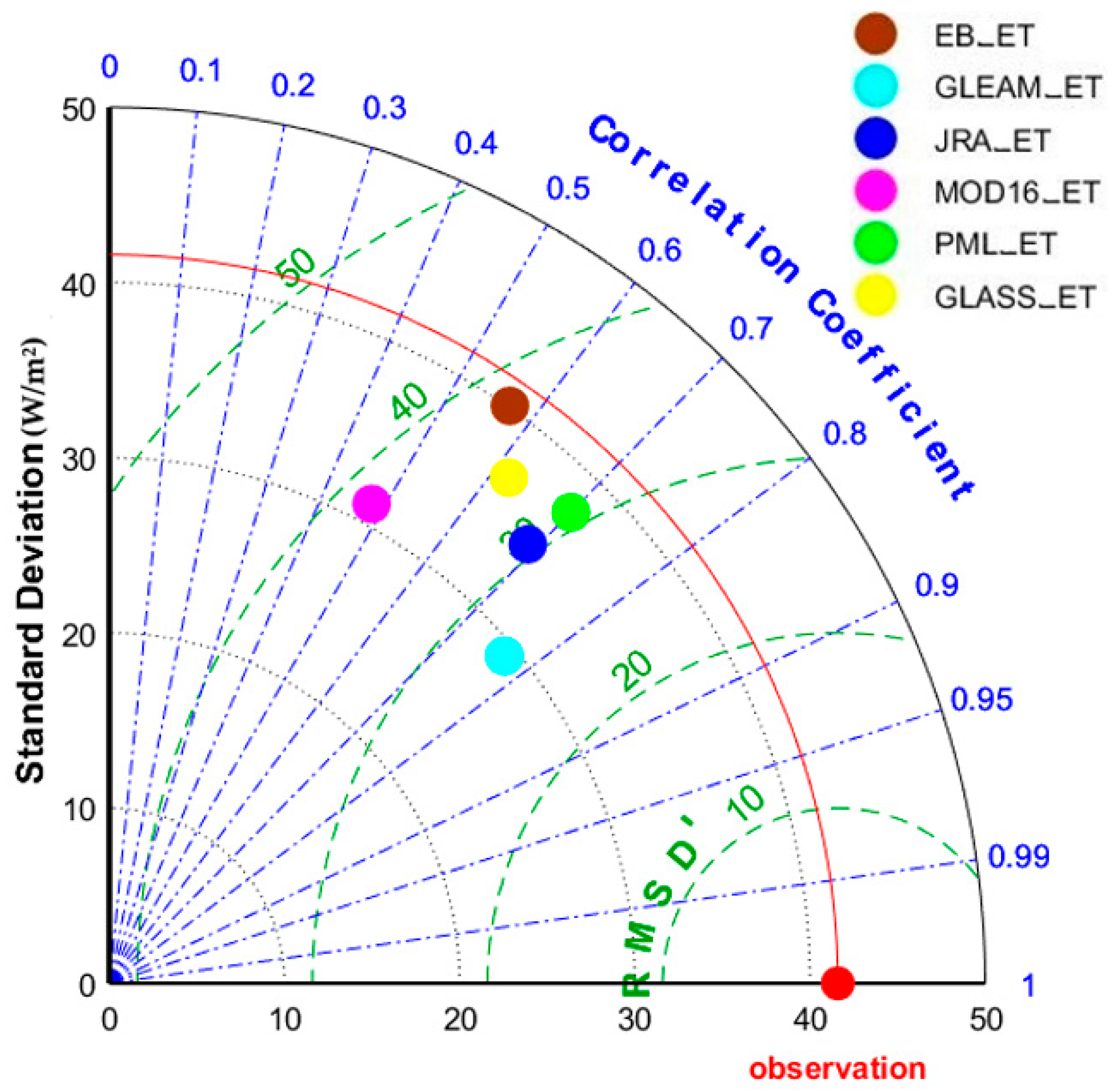
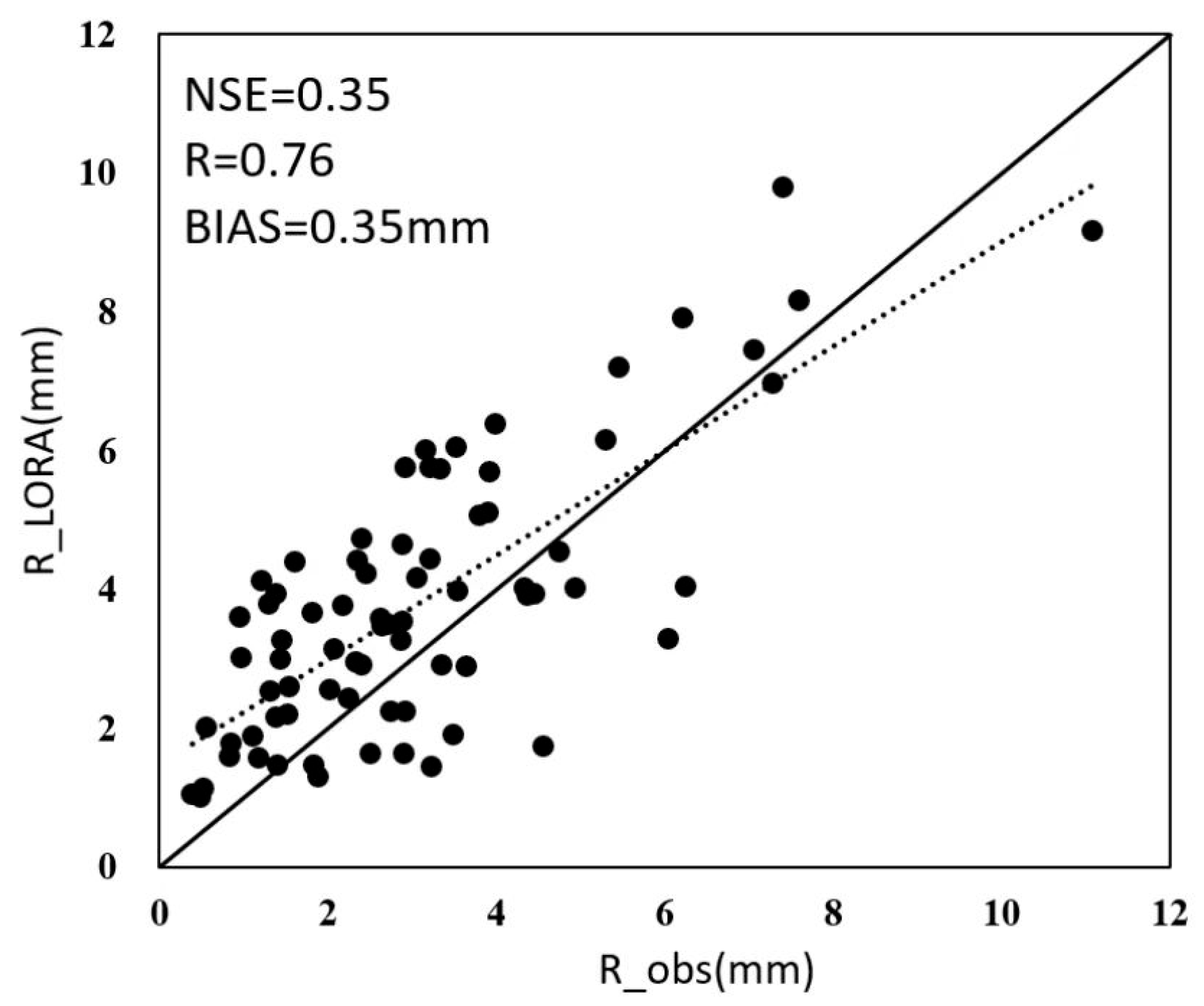
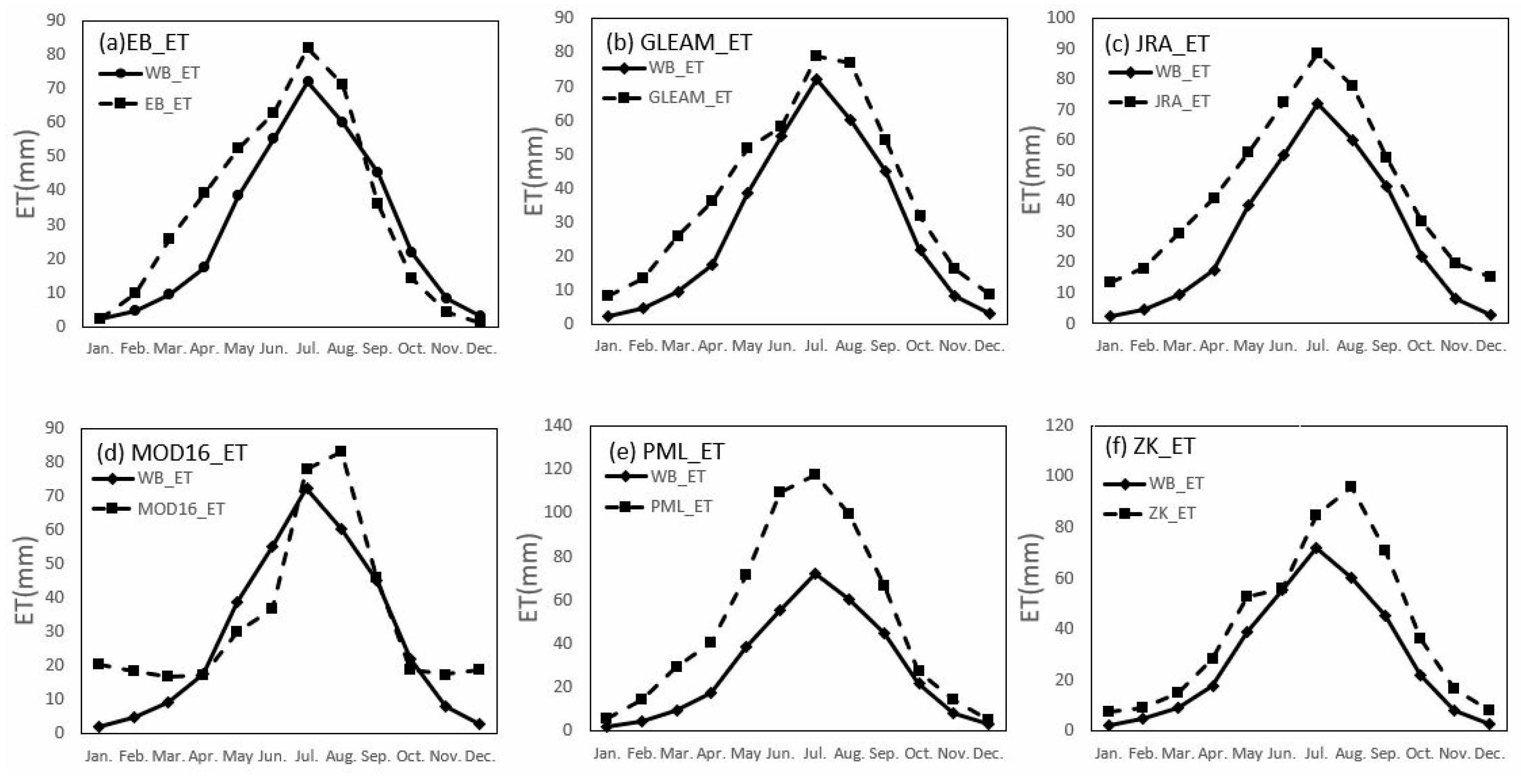
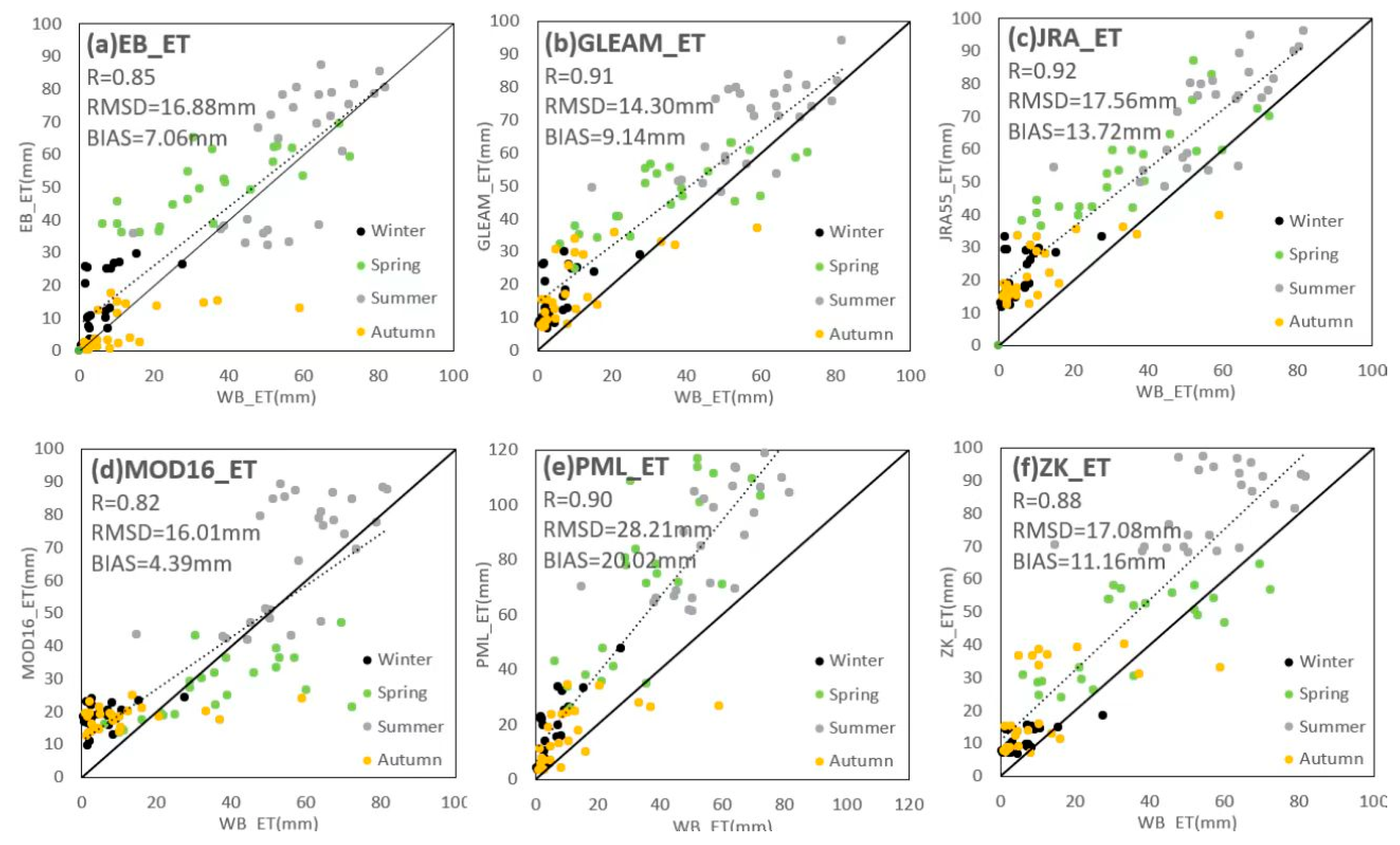
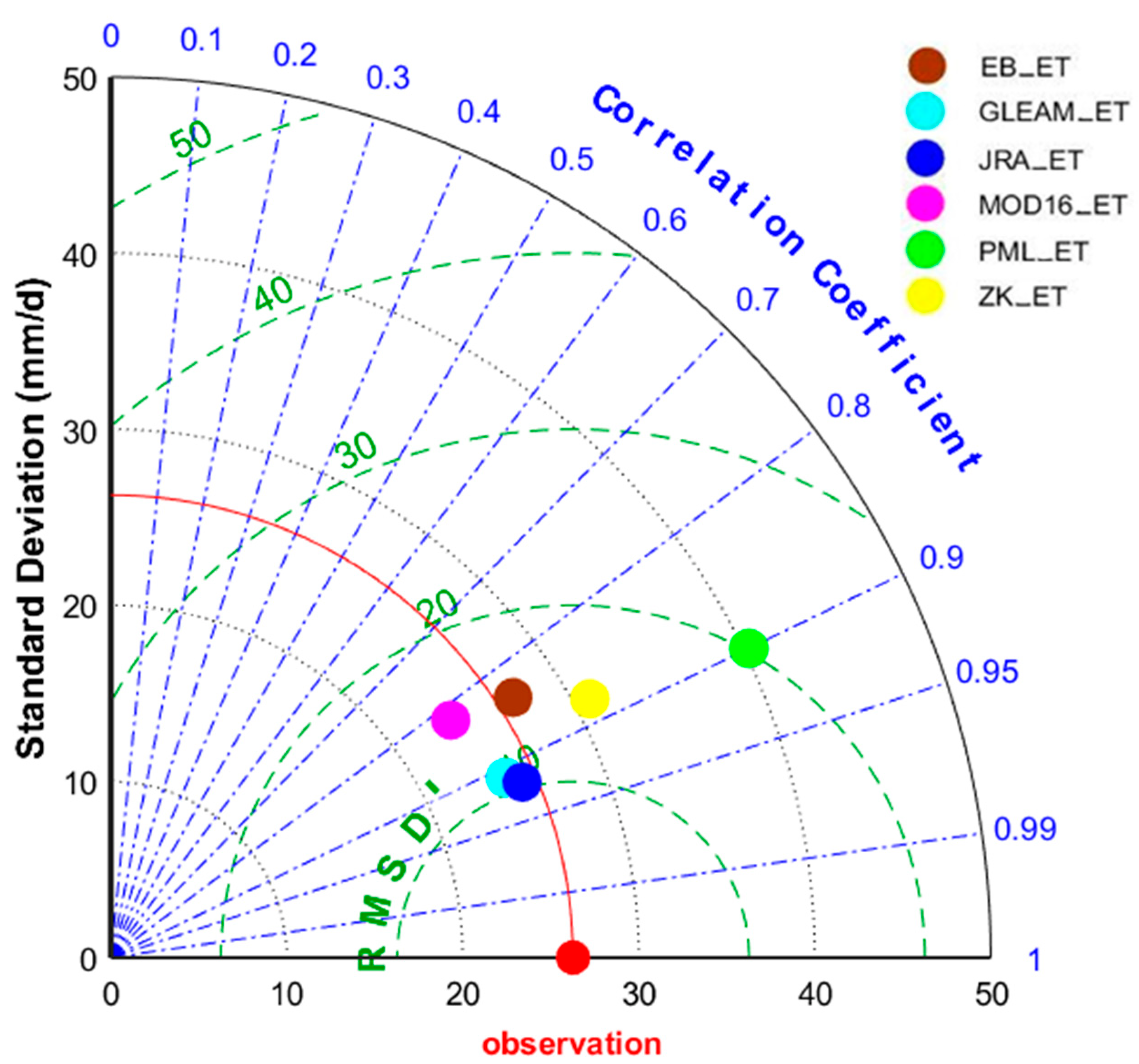
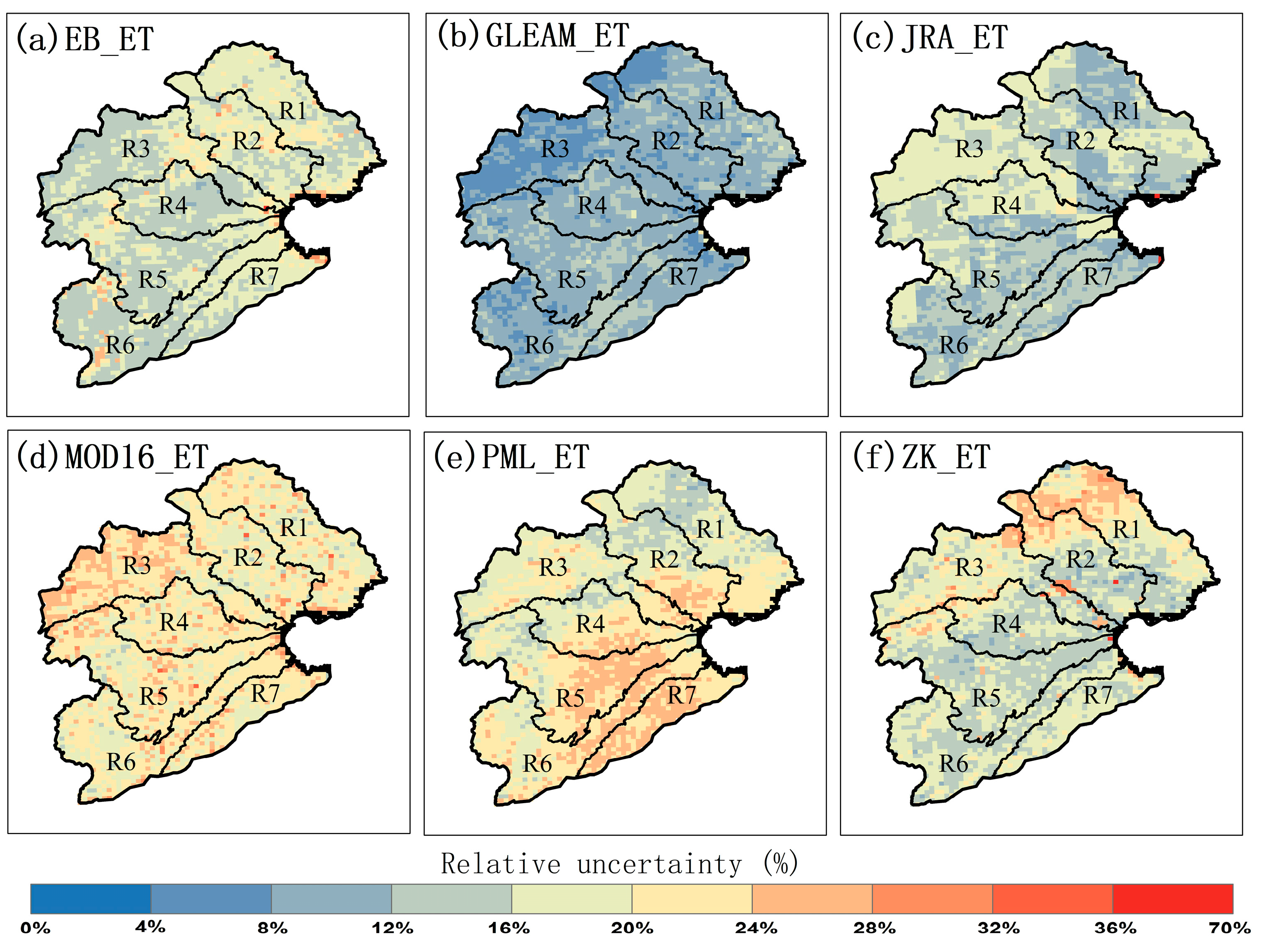
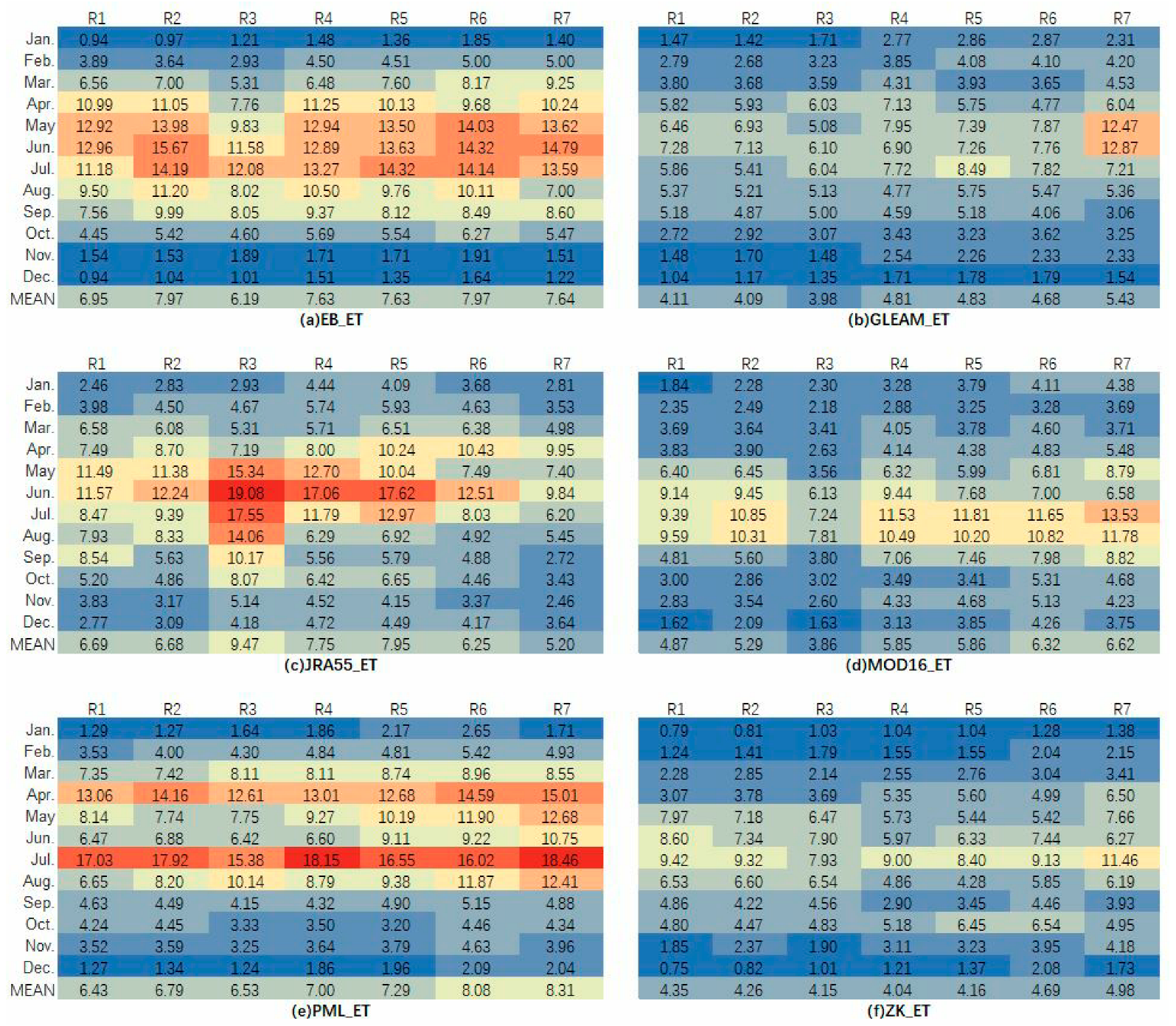
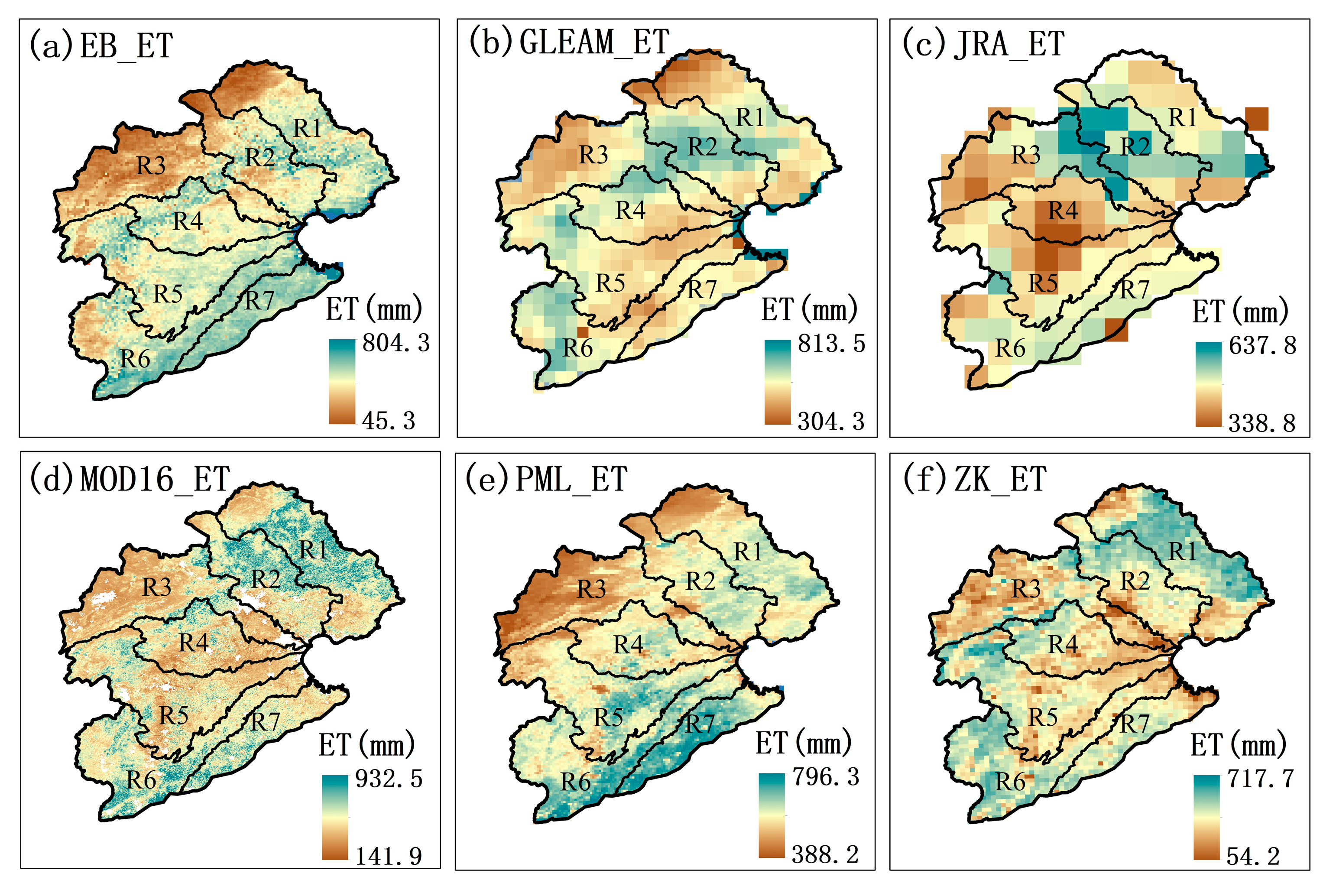
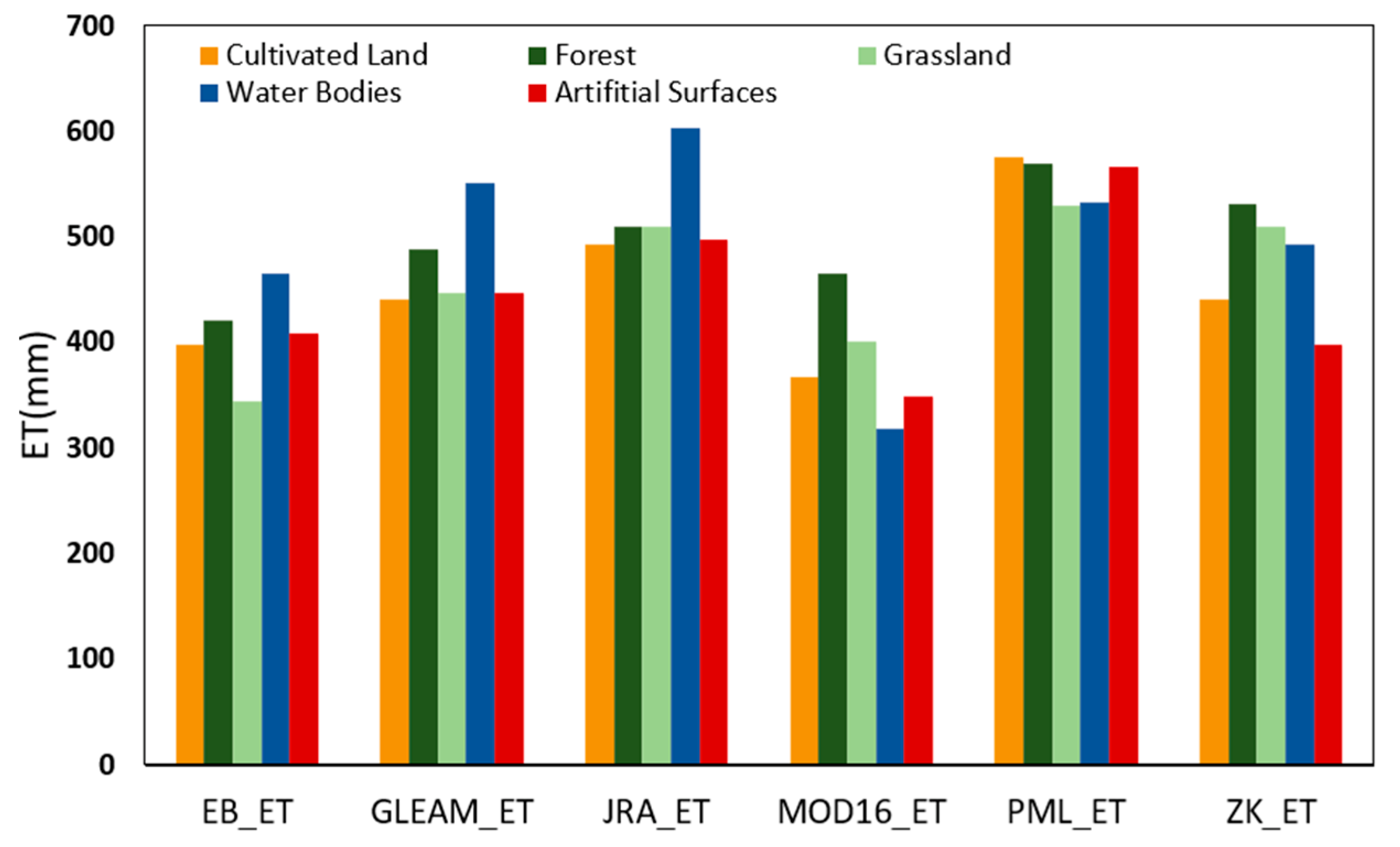

| Product Name | Approach | Temporal Resolution | Spatial Resolution | Units |
|---|---|---|---|---|
| EB_ET | SEBS, Re-analysis Data | Daily, monthly | 0.05° × 0.05° | mm |
| GLEAM_ET | Modified Priestley–Taylor, soil stress factor | Daily, monthly | 0.25° × 0.25° | mm |
| JRA_ET | Re-analysis | 6 h, Monthly | 0.5612° × 0.56162° | W/m2 |
| MOD16_ET | Modified Penman–Monteith-Leuning, surface conductance model | 8 day, monthly | 1 km × 1 km | mm |
| PML_ET | Modified Penman–Monteith-Leuning | 8 day | 500 m × 500 m | mm |
| ZK_ET | Modified Penman–Monteith for canopy and soil, Priestley-Taylor for water | Monthly | 0.1° × 0.1° | mm |
| GLASS_ET | Integrated | Daily every 8 days | 1 km × 1 km | W/m2 |
| EC Site Name | Land Cover | Region | Period | Longitude (°E) | Latitude (°N) |
|---|---|---|---|---|---|
| Yucheng | Wheat/corn | Shandong | 2003–2010 | 116.57 | 36.82 |
| Huailai | Corn | Hebei | 2013–2017 | 115.79 | 40.35 |
| Guantao | Wheat/corn, cotton | Hebei | 2008–2010 | 115.13 | 36.52 |
| Miyun | Orchard | Beijing | 2008–2010 | 117.32 | 40.63 |
| Daxing | Wheat/corn, orchard | Beijing | 2008–2010 | 116.43 | 39.62 |
| Index | Season | EB_ET | GLEAM_ET | JRA_ET | MOD16_ET | PML_ET | ZK_ET |
|---|---|---|---|---|---|---|---|
| R | Spr. | 0.77 | 0.8 | 0.84 | 0.82 | 0.81 | 0.79 |
| Sum. | 0.47 | 0.46 | 0.6 | 0.31 | 0.23 | 0.3 | |
| Fall | 0.76 | 0.88 | 0.91 | 0.89 | 0.89 | 0.87 | |
| Win. | 0.48 | 0.52 | 0.46 | 0.81 | 0.56 | 0.33 | |
| Yearly | 0.85 | 0.91 | 0.92 | 0.82 | 0.90 | 0.88 | |
| RMSD (mm) | Spr. | 19.83 | 16.36 | 19.68 | 9.82 | 27.3 | 13.11 |
| Sum. | 14.53 | 22.72 | 27.73 | 25.8 | 53.28 | 30.22 | |
| Fall | 15.76 | 12.02 | 12.36 | 13.89 | 12.47 | 14.77 | |
| Win. | 3.85 | 7.74 | 12.81 | 16.43 | 7.19 | 5.68 | |
| Yearly | 16.88 | 14.3 | 17.56 | 16.01 | 28.21 | 17.08 | |
| BIAS (mm) | Spr. | 17.32 | 13.29 | 17.15 | −0.73 | 22.84 | 8.42 |
| Sum. | 9.68 | 13.44 | 20.36 | 8.83 | 47.12 | 20.82 | |
| Fall | −8.56 | 2.36 | 4.16 | −3.49 | 5.07 | 8.87 | |
| Win. | 1.09 | 0.8 | 0.84 | 0.82 | 0.81 | 0.79 | |
| Yearly | 7.06 | 9.14 | 13.72 | 4.39 | 20.02 | 11.16 | |
| RMSD’ (mm) | Spr. | 9.66 | 9.54 | 9.65 | 9.79 | 14.95 | 10.05 |
| Sum. | 10.84 | 18.32 | 18.83 | 24.24 | 24.87 | 21.90 | |
| Fall | 13.23 | 11.79 | 11.64 | 13.44 | 11.39 | 11.81 | |
| Win. | 3.69 | 7.70 | 12.78 | 16.41 | 7.14 | 5.62 | |
| Yearly | 15.33 | 11.00 | 10.96 | 15.40 | 19.87 | 12.93 |
| EB_ET | GLEAM_ET | JRA55_ET | MOD16_ET | PML_ET | ZK_ET | |
| Non-mountainous area | 12.39 | 6.69 | 9.51 | 17.48 | 19.15 | 12.04 |
| Mountainous area | 12.81 | 5.58 | 11.18 | 17.12 | 14.03 | 14.89 |
| EB_ET | GLEAM_ET | JRA_ET | MOD16_ET | PML_ET | ZK_ET | |
|---|---|---|---|---|---|---|
| T | 0.946 | 0.940 | 0.928 | 0.852 | 0.952 | 0.942 |
| RN | 0.976 | 0.971 | 0.975 | 0.889 | 0.963 | 0.937 |
| P | 0.932 | 0.944 | 0.938 | 0.935 | 0.950 | 0.948 |
Publisher’s Note: MDPI stays neutral with regard to jurisdictional claims in published maps and institutional affiliations. |
© 2022 by the authors. Licensee MDPI, Basel, Switzerland. This article is an open access article distributed under the terms and conditions of the Creative Commons Attribution (CC BY) license (https://creativecommons.org/licenses/by/4.0/).
Share and Cite
Guo, X.; Meng, D.; Chen, X.; Li, X. Validation and Comparison of Seven Land Surface Evapotranspiration Products in the Haihe River Basin, China. Remote Sens. 2022, 14, 4308. https://doi.org/10.3390/rs14174308
Guo X, Meng D, Chen X, Li X. Validation and Comparison of Seven Land Surface Evapotranspiration Products in the Haihe River Basin, China. Remote Sensing. 2022; 14(17):4308. https://doi.org/10.3390/rs14174308
Chicago/Turabian StyleGuo, Xiaotong, Dan Meng, Xuelong Chen, and Xiaojuan Li. 2022. "Validation and Comparison of Seven Land Surface Evapotranspiration Products in the Haihe River Basin, China" Remote Sensing 14, no. 17: 4308. https://doi.org/10.3390/rs14174308
APA StyleGuo, X., Meng, D., Chen, X., & Li, X. (2022). Validation and Comparison of Seven Land Surface Evapotranspiration Products in the Haihe River Basin, China. Remote Sensing, 14(17), 4308. https://doi.org/10.3390/rs14174308





